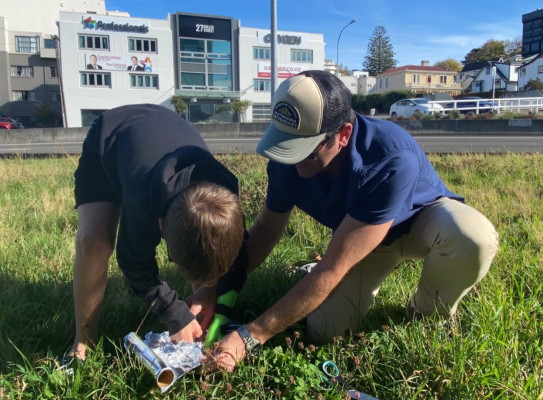Citizen science an eye opener with the Great Greenhouse Gas Grass Off

Last year GNS Science launched the #GreatGreenhouseGasGrassOff project and now national results are in. Grass sample testing during Level 4 lockdown showed a significant drop in fossil fuel CO2 emissions across the country.
Citizen science project #GreatGreenhouseGasGrassOff saw volunteers around New Zealand – armed with scissors and a nearby patch of grass – collecting weekly grass clippings during the initial COVID-19 lockdown.
These clippings were the key to GNS Science Climate Scientist Jocelyn Turnbull and the team in the Rafter Radiocarbon Lab being able to measure fossil fuel emission changes as the country moved from Level 4 to Level 1.

Jocelyn Turnbull
Radiocarbon Science Leader / Lead Scientist - Rafter Radiocarbon Laboratory
View bioAs grass grows, it absorbs carbon dioxide from the air. Testing in the lab allows the naturally occurring carbon in the samples to be distinguished from carbon produced by burning fossil fuels. With samples taken regularly over time, the team was able to paint a picture of carbon emissions across the level changes.
Sites across Wellington, Christchurch, Hamilton and Gisborne all showed a 75-80% drop in emission during Level 4 compared to Level 1.
Central Auckland locations also showed a decrease in emissions during lockdown, but not nearly as significant as Wellington sites which ranged from a 40-60% drop in emissions.
It’s important to note that grass clippings only reflect local conditions. The plants capture what’s happening in a roughly 100 square metre range
“So, what we’re seeing with these central Auckland sites is a mixture of emission sources, not just traffic. We’re picking up residential and commercial emissions too, which we don’t expect to have dropped so significantly during lockdown”.
Results from rural Canterbury also showed more modest change.
“We expect this might be because driving dropped less significantly in these areas during Level 4 as people continued with essential work”
Other interesting results came from two sites in Wellington, both on the median on Cambridge Terrace. The two sites showed similar 75-80% decreases during Level 4, but as we returned to ‘normal’ life and the Alert Levels decreased there were subtle differences in emissions level.
One site saw a steady increase and one saw a more abrupt return to pre-COVID lockdown emission levels – likely reflecting the fact that one site was close to traffic lights and the other was on a road near free-flowing traffic.
GNS Science is involved in ongoing urban greenhouse gas research through CarbonWatch NZ, a collaborative research programme involving NIWA, GNS Science, Manaaki Whenua and the University of Waikato. The project is evaluating New Zealand’s full carbon budget (both CO2 and methane) using a combination of atmospheric observations of CO2 and modelling approaches.
Right now with CarbonWatch, Auckland is the test case for our urban sampling, but we hope to expand to other New Zealand cities in the coming years, supporting councils and citizens to monitor and mitigate their greenhouse gas emissions
